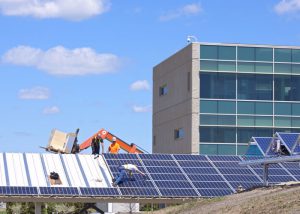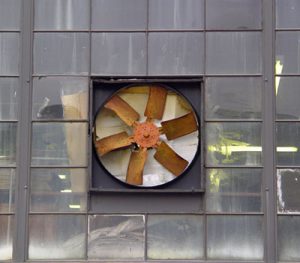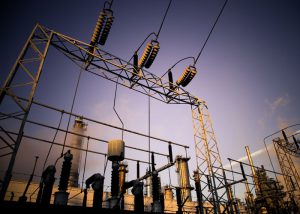Energy Efficiency & Reduction
Overview
A 2009 study completed at the University of Chicago estimated that the American healthcare sector accounts for nearly a tenth of the country’s carbon dioxide emissions, mainly from use of fossil fuels such as coal and natural gas, as well as from the indirect carbon footprint of the supply chain. When thinking about climate change and opportunities for mitigation, healthcare energy use cannot be ignored.
According to the American Hospital Association (2014), “inpatient health care facilities are the second most energy-intensive facility type across the nation.” It is estimated that these facilities use more than 73 trillion kWh of electricity and 341 trillion BTUs of natural gas annually. The carbon emissions associated with this electricity use alone translate to about “$600 million per year in health care costs due to increased asthma and other respiratory illnesses” (American Hospital Association, 2014). Thus, it not only makes financial and environmental sense to decrease healthcare’s energy footprint, but it also makes sense from a community health standpoint.
Energy Efficiency and Reduction Strategies
How can healthcare facilities lessen their energy footprint?
According to Energy Star’s Building Upgrade Manual (2014), the most common energy efficiency projects are:
-
-
- Retro-commissioning: ensuring that mechanical systems are functioning at optimal energy performance
- Lighting: installing energy-saving bulbs, removing lighting, and using occupancy sensors
- Load reduction: addressing the building envelope, such as insulation, windows, and roofing
- Air distribution systems: upgrading fan systems that supply the space with air flow
- Optimizing heating and cooling systems: a variety of upgrades can be implemented to lessen heating and cooling costs
-
There are also employee behavior-related strategies that healthcare facilities can use, such as:
-
-
 Taking advantage of computer “sleep” modes, which can be easily programmed by your IT department
Taking advantage of computer “sleep” modes, which can be easily programmed by your IT department- Purchasing Energy Star equipment for office appliances and equipment and EPEAT-registered computer equipment (see the universal waste section for more information on EPEAT)
- Turning off non-critical equipment at night and on weekends and unplugging equipment that is used infrequently
- Setting your heating and cooling thermostats to a specific temperature and refraining from adjustments throughout the day
- Creating an overall energy awareness campaign for staff so that they are exhibiting conservation behaviors such as shutting off lights when leaving the room or taking advantage of daylight rather than artificial light
-
Finally, the healthcare sector is beginning to look more seriously at renewable energy sources, such as:
-
-
- Installing solar arrays on rooftops, parking lots, or green spaces
- Purchasing wind credits from the utility provider
- Exploring opportunities for unconventional energy sources, such as geothermal or biomass
-
Energy Reduction Resources and Links
Healthcare organizations in Minnesota can take advantage of a number of resources available to help reduce your energy footprint.
Energy Reduction Assistance in Minnesota
-
-
- MnTAP Intern Program places student interns at facilities, typically during the summer season, to work on pollution prevention and energy efficiency projects. This unique program can assist you in developing a project to identify energy use and reduction opportunities. Read more about a 2013 intern project in Duluth, Minnesota: Energy Reduction Opportunities at St. Luke’s Hospital.
- Minnesota Energy Smart, an affiliate of the Minnesota Chamber of Commerce, “helps Minnesota businesses find ways to save energy and connect to financial incentives. The program is funded through state-approved utility conservation programs. All services are at no cost” (Energy Smart, 2014). They offer the following services to Minnesota businesses: on-site energy consultations, phone consultations, utility bill analysis, energy benchmarking and Energy Star ratings, upgrade investment analysis, project funding assistance, and workshops.
- Center for Energy and Environment (CEE), based in Minneapolis, is a nonprofit that “promotes energy efficiency to strengthen the economy while improving the environment” (CEE, 2014). CEE provides “financing and programs to help businesses and nonprofits reduce energy costs while improving occupancy comfort.” CEE also conducts Existing Building commissioning studies for medium-sized facilities. For smaller facilities, CEE offers the One-Stop lighting program for Xcel Energy customers. CEE can also provide energy benchmarking services to help determine where your facility falls in terms of energy use and your energy reduction opportunities.
- Minnesota GreenCorps is a statewide program to help “preserve and protect Minnesota’s environment while training a new generation of environmental professionals” (MN GreenCorps, 2014). The Minnesota Pollution Control Agency places AmeriCorps GreenCorps members at host facilities (government entities, educational organizations, and nonprofits) to serve for 11 months on focused environmental projects. Energy Conservation is one of four project categories. Host site applications are due in May of each year, with members starting each September. Visit their website to sign up for an email alerting you to when the GreenCorps application opens for the year.
-
Energy Regulatory Resources in Minnesota
-
-
- Minnesota Public Utilities Commission (PUC) regulates three services in Minnesota: electricity, natural gas, and telephone. In Minnesota, all rates (prices) for electricity and natural gas are set by the PUC. In other words, there is no opportunity to negotiate electricity or natural gas rates with your utility provider. The PUC also investigates the following topics related to electricity and natural gas: rate changes, energy resource planning and certification, service area matters, mergers and acquisitions, and formal complaints. The commission has also been actively engaged in monitoring the structural changes occurring in these industries, such as construction or modification of power plants, transmission lines, wind power generation plants, and large natural gas and petroleum pipelines (Minnesota Public Utilities Commission, 2014).
- Minnesota Department of Commerce – Energy Division has resources and information for Minnesota businesses and residents. Visit their website to find updates on energy legislation, financial resources like grants and loans for energy-related upgrades, energy efficiency tips and ideas, data on energy use in Minnesota, information about the Made in Minnesota Solar Incentive Program, heating and weatherization assistance, and conservation improvement programs (CIP).
 Minnesota Pollution Control Agency (MPCA) enforces air rules in Minnesota. This includes air emission permits, emission monitoring, and reporting. The MPCA also maintains resources and information about climate change, particularly as it relates to greenhouse gas emissions in our state. Also relevant to healthcare, the MPCA regulates hazardous waste in Minnesota; for more information, visit the healthcare hazardous waste page.
Minnesota Pollution Control Agency (MPCA) enforces air rules in Minnesota. This includes air emission permits, emission monitoring, and reporting. The MPCA also maintains resources and information about climate change, particularly as it relates to greenhouse gas emissions in our state. Also relevant to healthcare, the MPCA regulates hazardous waste in Minnesota; for more information, visit the healthcare hazardous waste page.
-
Healthcare Energy Resources Nationally
-
-
- The American Hospital Association has developed a Sustainability Road map for Hospitals. Their website has good information about reducing energy in the healthcare sector.
- U.S. Environmental Protection Agency (EPA) has information about measuring and reducing your energy impact, as well as Energy Star.
- Healthier Hospitals Initiative is a free program available to all U.S. hospitals and healthcare providers. You can sign up to participate in challenges, including an energy challenge.
- Practice Greenhealth is a membership-based nonprofit organization that provides technical assistance to participating healthcare facilities. Their website contains a wealth of information on energy use and reduction.
- Healthcare Without Harm is a nonprofit organization that advocates for a healthier healthcare industry, and their website contains information about the impacts of climate change and energy use on human health.
- S. Energy Information Administration (EIA) is a division of the federal government that analyzes and publishes information on both energy use and energy sources here and around the world.
- S. Department of Energy (DOE) has a mission to “ensure America’s security and prosperity by addressing its energy, environmental, and nuclear challenges through transformative science and technology solutions.”
-
References
American Hospital Association (2014). Sustainability roadmap for hospitals: Energy. Retrieved from http://www.sustainabilityroadmap.org/topics/energy.shtml#.UzxUt1dnBnJ.
Energy Star (2014). Building upgrade manual. Retrieved September 18, 2014 from http://www.energystar.gov/buildings/facility-owners-and-managers/existing-buildings/save-energy/comprehensive-approach/energy-star?c=business.bus_upgrade_manual.
University of Chicago Medical Center (2009). Health care accounts for eight percent of U.S. carbon footprint. Retrieved from http://www.uchospitals.edu/news/2009/20091110-footprint.html.
